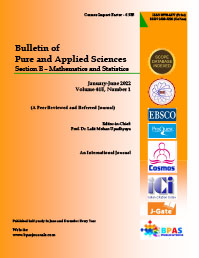Comparative study of exponential smoothing models and Box Jenkins ARIMA model of partitioned data of daily stock prices of the CRDB Bank in Tanzania ∗
DOI:
https://doi.org/10.48165/Keywords:
Time series analysis, ARIMA model, Simple, Double and Damped trend linear exponential smoothing methods, ACF and PACFAbstract
Data mining techniques and other analytical techniques have played a sig nificant role in analysing data from different sources. Data from stock market consist of high volatility and hence it needs a special care to fit a model for forecasting future stock prices values. In the stock market, investors trade to get positive returns through buying at a lower price and selling at a higher price. However, not all investors get positive re turns on their investment in stock market because of large amount of risk involved in the stock market due to vast fluctuation in the stock market prices.This study is conducted to compare and select the best model among autoregressive integrated moving average (ARIMA), single exponential smoothed model (SES), double exponential smoothed model (DES), and Damped trend linear exponential smoothed model. The modelling process was preceded by analysing the time series which revealed the presence of non-stationarity. The resultant models were found as ARIMA(1,1,2), Simple Exponential Smoothing (SES) and Double exponential smoothing (DES) whose parameters’ estimates were also found to be statistically significant. Akaike’s Information Criterion (AIC) and Bayesian Infor mation Criterion (BIC) were used to select the best model among all the three fitted models. The performance of the fitted model is analyzed and the market behavior for future forecast is studied. ARIMA(1,1,2) is selected as the best model for daily stock forecasting for the CRDB bank in Tanzania.
References
Abdalla, Kassim Ali (2014). An empirical analysis exploring relationship between macroeconomic variables and stock market return: A study of Dar es Salaam stock exchange (DSE), A Dissertation submitted in partial fulfillment of the requirements for the award of the Degree of Master of Science in Accountancy and Finance of Mzumbe University. http://hdl.handle.net/11192/887
CRDB Bank Annual Report. (2018). https://crdbbank.co.tz/wp-content/uploads/2019/05 [3] Devi, B.U., Sundar, D. and Alli, P. (2013). An effective time series analysis for stock trend predic tion using ARIMA model for Nifty Midcap-50, International Journal of Data Mining & Knowledge Management Process, 3(1), 65–78. https://doi.org/10.5121/ijdkp.2013.3106 [4] Green, S. (2011). Time series analysis of stock prices using the Box-Jenkins Approach, Electronic Theses & Dissertations, 156. Retrieved from files/206/ Green-2011-TimeSeriesAnalysisofStockPricesUsingtheBox-JenkinsApproach.pdf [5] Latha, C.M. and Nageswararao, K.S. (2018). Forecasting time series stock returns using arima, Evidence from S & P BSE Sensex, 118(24), 1–21.
Saini, S., Singh, N.P. and Laxmi, Ratna Raj (2016). Application of ARIMA models in forecasting stock prices, International Journal of Mathematics and Computer Applications Research (IJM CAR), 6(6), 1–10.
Miiler, T. (1993). Seasonal exponential trends - an application smoothing planning with damped for production, International Journal of Forecasting, 9, 509–515.
Nandakumar, R.R.U.K. and Lokeswari, Y.V. (2018). Stock price prediction using long short term memory, International Research Journal of Engineering and Technology, 5(3), 3342–3348. Re trieved from www.irjet.net
Ogoteng, O. (2017). Stock returns behaviour and the pricing of volatility in Africa’s equity mar kets.Dissertation Masters in Management of Finance and Investment, WITS Business School, University of the Witswatersrand, Johannesburg, South Africa. https://pdfs.semanticscholar. org/111e/a3aa2697e13875f0dab4ec651e5b5768ee18.pdf
Pang, X., Zhou, Y., Wang, P., Lin, W. and Chang, V. (2018). Stock market prediction based on deep long short term memory neural network, in Proceedings of the 3rd International Conference on Complexity, Future Information Systems and Risk (COMPLEXIS 2018), 102–108 (ISBN: 978- 989-758-297-4). DOI: 10.5220/0006749901020108.
Singh, Kuljeet, Shastri, Sourabh, Bhadwal, Arun Singh, Kour, Paramjit, Kumari, Monika, Sharma, Anand and Mansotra, Vibhakar (2019). Implementation of exponential smoothing for forecasting time series data, International Journal of Scientific Research in Computer Sci ence Applications and Management Studies, 8(1). https://www.researchgate.net/publication/ 330970319 Implementation of Exponential Smoothing for Forecasting Time Series Data
Subashini, A. and Karthikeyan, M. (2018). Forecasting on stock market time series data us ing data mining techniques, International Journal of Engineering Science Invention (IJESI), 6–13. Retrieved from www.ijesi.org, http://www.ijesi.org/papers/NCIOT-2018/Volume-4/2. %2006-13.pdf
Zhang, H. (2013). Modeling and forecasting regional GDP in Sweden using autoregressive models, Master’s Thesis in Microdata analysis, Business Intelligence Program, School for Technology and Business Studies, Dalarna University, Sweden.
Marisa, Angila and Cancela, Roldao (2008). Comparative study of artificial neural network and Box- Jenkins ARIMA for stock price indexes, Dissertation for the degree of Master in Data Analysis Prospecting, ISCTE Business School. https://repositorio.iscte-iul.pt/bitstream/ 10071/1472/1
Owusu, Frank Kofi (2010). Time series ARIMA modelling of inflation in Ghana, A Thesis sub mitted to the Department of Mathematics, Kwame Nkrumah University of Science and Tech
K.K. Saxena and Juma Salehe Kamnge
nology in partial fulfillment of the requirements for the degree of Master of Science. http: //hdl.handle.net/123456789/866
Awokuse, T. and Ilvento, T. (2012). Using Statistical Data to Make Decisions Mod ule 6: Introduction to Time Series Forecasting, University of Delaware, College of Agri culture and Natural Resources, Food and Resource Economics. https://docplayer.net/ 7292575-Module-6-introduction-to-time-series-forecasting.html
[stockpriceF,stockpriceMSE] = forecast(ARIMA stockprice,20,‘Y0’,stockprice); UB = stockpriceF + 1.96*sqrt(stockpriceMSE);
LB = stockpriceF - 1.96*sqrt(stockpriceMSE);
dateF = date(end) + days(1:2o);
figure
h4 = plot(date,stockprice,‘Color’,[.75,.75,.75]);
hold on
h5 = plot(dateF,stockpriceF,‘r’,‘LineWidth’,2);
h6 = plot(dateF,UB,‘k–’,‘LineWidth’,1.5);
plot(dateF,LB,‘–’,‘LineWidth’,1.5);
legend([h4,h5,h6],‘stock price for CRDB’,‘Forecast’,...
‘Forecast Interval’,‘Location’,‘Northwest’)
title(‘Stock price for CRDB Forecast’)
xlabel(‘years’)
ylabel(‘stock price’)
hold off
Appendix 2: Code for R Software
code for software
#loading data into R software
library(readxl)
p3 <- read excel(“C:/Users/hp/Desktop/gebo/juma/p3.xlsx”)
view(p3)
#for performing ARIMA and AUTOARIMA
attach(p3)
library(readxl)
library(forecast)
# Defining variables
Y <-closing price
d.Y<- diff(Y)
dd.Y<-diff(d.Y)
t <-date
arimafit<- auto.arima(Y)
fcast<- forecast(arimafit)
plot(fcast)
standardize residuals<-residuals(arimafit)
hist(standardize residuals,plot = TRUE,main = “Histogram of standardize residual”) y=rnorm(1885)
qqplot(standardize residuals,y,plot = TRUE)
acf(residuals(arimafit),plot = TRUE,lag.max = 20)
Box.test(residuals(arimafit),lag = 20,type = “Ljung-Box”,fitdf =1)
tsdiag(arimafit)
